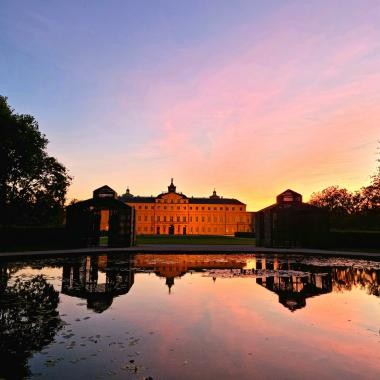The most important historical monument in Rastatt is the Residential Palace, the oldest baroque residence on the upper Rhine. Margrave Ludwig Wilhelm von Baden (1655 – 1707) commissioned the Italian architect Domenico Egidio Rossi to erect this baroque complex exactly at the axis between the Alsatian Fort Saint Louis and Margravian castle Ettlingen. The models for Rossi’s creation were the Palace of Louis XIV, the French “sun king” in Versailles and the City Palace of the Viennese nobility.
The margrave family moved into the generously planned but partially still under construction residence in the autumn of 1705. After Ludwig Wilhelm‘s death, his widow, the margravine Sibylla Augusta hired her Bohemian architect Johann Michael Ludwig Rohrer to continue the work on the Palace.
On March 6, 1714, the Rastatt Residential Palace was the focal point of European history: Prince Eugene of Savoy (for the Kaiser) and Marshal Villars (for Louis XIV.) signed the Peace of Rastatt here and together with the peace treaties in Utrecht (1713) and Baden, Switzerland (1714), this ended the War of the Spanish Succession.
After the death of the margravine, her son, margrave Ludwig Georg took over the residence and added décor elements in rococo style. After the extinction of the Baden-Baden male monarchy line in 1771, the margraviate and with it the Residential Palace fell to the margraves of Baden-Durlach. Rastatt was now only a secondary residence.
In the 19th century, the Palace served as a fortress headquarter. Today, you can find memorials for the freedom movements in German history, the Military History Museum and the Local court in parts of the basement of the Corps de Logis and in the wings. In State rooms on the upper floor, the Beletage [the second floor], can be seen in their former grandeur are after extensive renovations. The frescoed ceilings of Italian artists and the magnificent baroque moldings are particular highlights. The ancestral hall, which is taller and larger than the rest of the rooms, is a ceremonial and artistic highlight of the residence. Stucco figures in the fillet of the ceiling depict Turkish prisoners and remind of the victories of the margraves over the Ottoman legions. Paintings along the walls depict the ancestors of the margravian family.
The Rastatt palace complex is being serviced and maintained by the state of Baden-Württemberg at great cost.
Children discover Rastatt:
Every period has its own architectural style. Many of the buildings in Rastatt were built in the “baroque period”. That was the era around 1700, more than 300 years ago. The ruling princes and the church as well displayed their wealth and power with these. The Rastatt Residential Palace with its more than 300 rooms is the largest and most beautiful building in the city.
The symbol of the city, the “Golden Man” can be seen on its roof. This gilded statue of the Roman god Jupiter flings a bundle of lightning bolts in the direction of the enemies with his right hand.
From up there, Ludwig the town mouse and his friends Siri and Bonnie, the palace mice Matteo and Lennox, the tower hawks as well as Maello, the commander of the mouse fire brigade and Manolo, the Spanish jumping mouse have the best view of what goes on in Rastatt.
The residents of Rastatt are very proud of their Palace in the middle of the city and you can visit the staterooms and two other museums here. Exhibitions of the memorials for the freedom movements in Germany and the Military History Museum here are unique in Germany.
Do you want to dress up as a prince or princess? Come with your school class or with your friends and spend a few hours in a different era! Imagine this: you can even get married in the Palace. The palace mice will be especially happy to see so many guests.
Back to the overview



_Paul%20Gärtner.jpg?f=%2Fsite%2FRastatt-Tourismus%2Fget%2Fparams_E-1783803689%2F2993914%2F01_Residenzschloss%2520%252816%2520von%252019%2529_Paul%2520G%25C3%25A4rtner.jpg&w=724&h=724&m=C)

%202017.jpg?f=%2Fsite%2FRastatt-Tourismus%2Fget%2Fparams_E-2080596129%2F2993935%2FSchlosskirche%2520Innenaufnahme%2520%2528Staatliche%2520Schl%25C3%25B6sser%2520und%2520G%25C3%25A4rten%2520Baden-W%25C3%25BCrttemberg%2529%25202017.jpg&w=380&h=380&m=C)